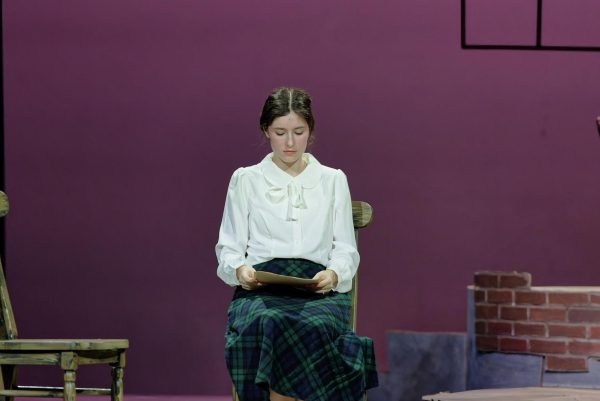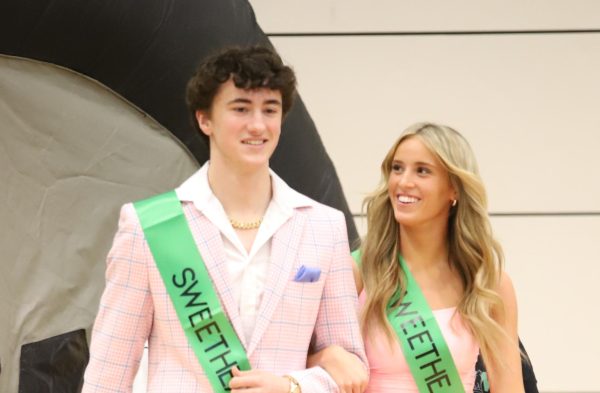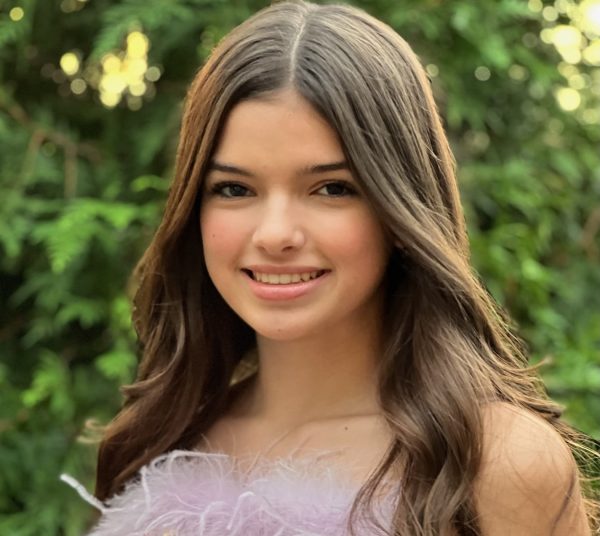Colorblind teacher and students see things from a different perspective
 While performing a chromatography lab in AP Chemistry, senior Cole Nelson had to record phase changes or color changes. An unknown dye was put on a piece of filter paper and then set in a beaker filled with water. The water climbed up the paper and brought the dye along with it, while simultaneously separating the individual colors within that dye. For this lab, Nelson said he had difficulties determining what individual colors made up the unknown dye because it was a mixture of blues, greens and purples, and Nelson lives with a color blindness called protan.
While performing a chromatography lab in AP Chemistry, senior Cole Nelson had to record phase changes or color changes. An unknown dye was put on a piece of filter paper and then set in a beaker filled with water. The water climbed up the paper and brought the dye along with it, while simultaneously separating the individual colors within that dye. For this lab, Nelson said he had difficulties determining what individual colors made up the unknown dye because it was a mixture of blues, greens and purples, and Nelson lives with a color blindness called protan.
For Nelson, blue and purple; and red and green get mixed up. The reality for the small percentage of people who are living with color blindness is that they jumble up colors which are similar in shade. This selective group sees color through its own eyes and perceives it differently from other individuals.
“Color blindness, actually, is more of a social definition; it is the inability to see the myriad of colors and the diversity of colors that other people can see,” biology teacher Lynn Martens said. “As primates, we began with having color blindness as a species.”
Martens said the chance for having color blindness is astronomically higher for males versus females and is inherited. This is because it is part of the X chromosome and, typically, men only have one, unlike females who have two. The majority of people do not realize they are colorblind until they are forced to participate in an activity requiring differentiability of colors. Although people usually realize color blindness in the early elementary grades, sometimes it happens later because colors become less prevalent as one matures. Despite the fact that the person realizes at an early age, others may not know until later because it is not something that can be noticed.
“[People] always ask me what color everything is, and it’s really annoying,” Nelson said. “It’s just that they’re startled at first because they don’t know a lot of people that are [colorblind]. I mean, after time they just get used to it.”
 Junior Joey Carrigan and Nelson said they found out they were colorblind as young children. However, history teacher Dustin Leochner said he didn’t find out until early in his high school career. In spite of the various ways the news was received, they all found out in the same place: school.
Junior Joey Carrigan and Nelson said they found out they were colorblind as young children. However, history teacher Dustin Leochner said he didn’t find out until early in his high school career. In spite of the various ways the news was received, they all found out in the same place: school.
“My initial reaction was that I thought maybe my mom had played a dirty trick on me and told me brown is green and green is brown my whole life, but I knew that wasn’t the case,” Leochner said. “I mean, like a lot of things kind of made sense after that. I wore a lot of green clothes because I thought they were brown or tan and they weren’t. I’m sure people wondered why I was wearing that much green, and I didn’t even realize. Those were two colors that I really kinda had some problems with.”
According to “Colour Blind Awareness,” there are numerous kinds of color blindness, such as trichromacy, dichromacy and monochromacy. Within these, there are subtypes, such as protanopia and deuteranopia. The rarest type is monochromacy, which means the person cannot see any color, and they would see in black and white. Deutan, also known as red-green ww, is the most common color deficiency.
“In my strong protan type [of color blindness] you can only see 50,000 different shades of colors whereas the normal person can see 1 million,” Nelson said. “It kind of takes away all the other colors.”
Because some colors are mixed up or taken away from the vision of those who are colorblind, some school subjects may cause problems. Nelson said he had trouble in some of his science classes with labs such as those in chemistry or physics.
 However, on the other hand, Carrigan said he doesn’t really have any difficulty due to the fact that most of higher level learning is done from a textbook. Because this is not always true, Martens said in the classes she teaches, she compensates by having students focus on shadow, texture and depth first, while drawing various body organs and coloring later. Martens said she has around three or four students who are colorblind every year.
However, on the other hand, Carrigan said he doesn’t really have any difficulty due to the fact that most of higher level learning is done from a textbook. Because this is not always true, Martens said in the classes she teaches, she compensates by having students focus on shadow, texture and depth first, while drawing various body organs and coloring later. Martens said she has around three or four students who are colorblind every year.
“They have to advocate for themselves and tell the teacher because we can’t read minds,” Martens said. “The student will just ask for a clarifier, so I don’t think it affects their understanding of certain concepts, but it can add an extra step in decoding.”
Color blindness is merely a vision deficiency and those who are color blind just see the world in varying hues. Both Carrigan and Nelson said they are curious to find out how people without color blindness see things and there is a way to do so.
“There’s a type of glasses, EnChroma; they are pretty expensive, and I don’t think they are worth that much,” Carrigan said. “I’ve seen some videos of the difference [between seeing with and without certain colors] and people’s reactions to it, and I think it would be pretty cool.”
According to “EnChroma”, these glasses were first launched in 2012. However, EnChroma decided to make a second version of these glasses in 2014, with a more updated technology. They made the switch from all-glass lenses to all-plastic ones. This allowed the glasses to have the capability to be prescribed along with greater acceptance by eyecare professionals.
Although, these glasses are not for everyone. For some people, color blindness is just their own glimpse of the world around them. These people have no aspiration to change the way they look at everything surrounding them.
“Nope, I’ve never had that desire [to see differently],” Leochner said. “It is just my reality, you know, I personally don’t even think it’s that strange or unique. I guess it’s just how I see the world and it’s just how I perceive things. It doesn’t really bother me and I’m not envious of people who see normal colors or don’t struggle to distinguish certain colors.”


















